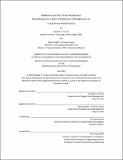| dc.description.abstract | Though critical to the US economy and moving the majority of US freight, the American trucking industry faces three compounding challenges: driver shortage, low driver utilization, and high driver turnover. Previous studies have found that, though scarce, drivers are underutilized and prone to frequent employment changes, further exacerbating the shortage problem. To identify the root causes and offer potential solutions, this study investigates the impact of carrier dispatchers on truck driver performance. This performance was measured by three key metrics: Hours of Service utilization, average miles driven per day efficiency, and employee retention. ELD and TMS data from a midsized carrier was run through regression and clustering machine learning algorithms to evaluate the features impacting these metrics. It was found that dispatchers indeed impact driver performance and have at least three managerial levers that can be used to improve fleet performance, including the weekday a driver works, the equality of distribution of freight plans, and the size of the team a dispatcher manages. With these levers, freight carriers can themselves mitigate the impact from the challenges facing the American freight industry today. | en_US |
